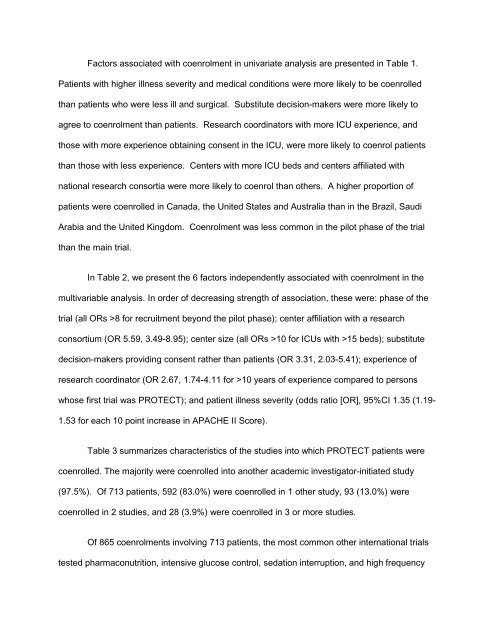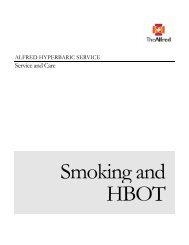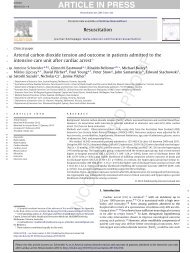Critical Care
See Full Article - Alfred Intensive Care Unit
See Full Article - Alfred Intensive Care Unit
- No tags were found...
Create successful ePaper yourself
Turn your PDF publications into a flip-book with our unique Google optimized e-Paper software.
Factors associated with coenrolment in univariate analysis are presented in Table 1.<br />
Patients with higher illness severity and medical conditions were more likely to be coenrolled<br />
than patients who were less ill and surgical. Substitute decision-makers were more likely to<br />
agree to coenrolment than patients. Research coordinators with more ICU experience, and<br />
those with more experience obtaining consent in the ICU, were more likely to coenrol patients<br />
than those with less experience. Centers with more ICU beds and centers affiliated with<br />
national research consortia were more likely to coenrol than others. A higher proportion of<br />
patients were coenrolled in Canada, the United States and Australia than in the Brazil, Saudi<br />
Arabia and the United Kingdom. Coenrolment was less common in the pilot phase of the trial<br />
than the main trial.<br />
In Table 2, we present the 6 factors independently associated with coenrolment in the<br />
multivariable analysis. In order of decreasing strength of association, these were: phase of the<br />
trial (all ORs >8 for recruitment beyond the pilot phase); center affiliation with a research<br />
consortium (OR 5.59, 3.49-8.95); center size (all ORs >10 for ICUs with >15 beds); substitute<br />
decision-makers providing consent rather than patients (OR 3.31, 2.03-5.41); experience of<br />
research coordinator (OR 2.67, 1.74-4.11 for >10 years of experience compared to persons<br />
whose first trial was PROTECT); and patient illness severity (odds ratio [OR], 95%CI 1.35 (1.19-<br />
1.53 for each 10 point increase in APACHE II Score).<br />
Table 3 summarizes characteristics of the studies into which PROTECT patients were<br />
coenrolled. The majority were coenrolled into another academic investigator-initiated study<br />
(97.5%). Of 713 patients, 592 (83.0%) were coenrolled in 1 other study, 93 (13.0%) were<br />
coenrolled in 2 studies, and 28 (3.9%) were coenrolled in 3 or more studies.<br />
Of 865 coenrolments involving 713 patients, the most common other international trials<br />
tested pharmaconutrition, intensive glucose control, sedation interruption, and high frequency









